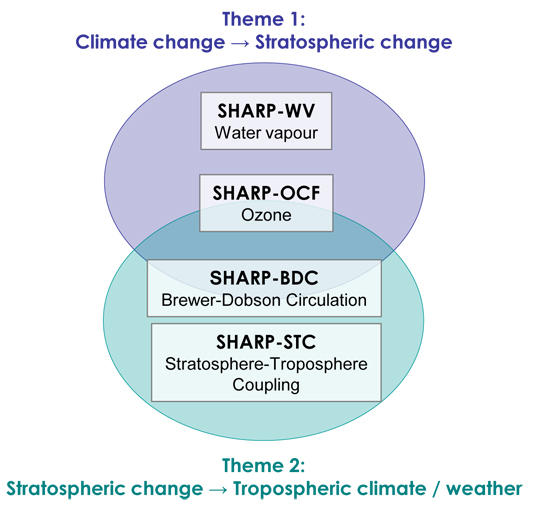Interactions between the Projects Phase I
The topic of SHARP is interdisciplinary requiring expertise in atmospheric dynamics and chemistry, numerical modelling with complex numerical models, as well as data analysis from satellite platforms and in-situ measurements. Each member of the consortium has expertise on a specific sub-topic but only as a consortium in a Research Unit they provide all disciplines necessary to answer the challenging scientific questions of future climate change. With their different background and tools the SHARP partners form an excellent team and will be able to fulfil the tasks selected for SHARP.
The four scientific projects are defined to investigate the two overlapping research themes that were selected for SHARP, as illustrated in Figure 5. Each project has its specific topic but all projects are interrelated and contribute to both research themes. Only by collaboration they will reach their full potential.
SHARP-WV (with focus on stratospheric water vapour) and SHARP-OCF (with focus on stratospheric ozone) will primarily investigate the impact of increasing greenhouse gas concentrations and climate change on stratospheric composition (Theme 1). Likewise, SHARP-BDC will focus on the impact of climate change on changes in stratospheric dynamics, particularly the Brewer-Dobson circulation (Theme 1). At the same time, the results of these three projects will provide information on resulting stratospheric changes that are needed to study the feedback of stratospheric change on tropospheric climate and weather which is the main topic of SHARP-STC (Theme 2).
A particular link exists between SHARP-BDC and SHARP-STC as nearly all simulations with numerical models performed in SHARP will be carried out in these two projects. The simulations will be jointly defined and coordinated in order to provide the best possible basis not only for a detailed investigation of the specific questions in each individual project but also for a common analysis of model data and respective observations in the other SHARP-projects.

Figure 5: Integration of SHARP scientific projects into SHARP research themes.
Transient reference simulations with the two CCMs describing the historical and possible future evolution of the atmosphere will be ready for analysis at the beginning of SHARP. They are performed in 2008 in connection with the EC-project SCOUT-O3 and the SPARC CCMVal activity for the upcoming WMO/UNEP ozone assessment in 2010 (see SHARP-STC). Results of REF1 and REF2 simulations with the CCMs E39C-A (DLR) and ECHAM5/MESSy (FUB, MPI-C) will build the basement for analyses which will be carried out in SHARP-BDC and SHARP-STC. Output of these simulations will be provided to SHARP-OCF and SHARP-WV to allow detailed analyses of specific processes relevant to explain long-term changes of stratospheric ozone and water vapour concentrations. This represents an important link of model results to observational data. The capability of models to describe present and past observations is a prerequisite for quantifying the contribution of various processes to variability and long-term trends in atmospheric composition and will allow us to assess their ability to predict future changes. Members of SHARP-BDC and SHARP-STC will provide necessary support to use the model data and to perform additional analyses. As these REF simulations are embedded into international activities, communication with external partners and exchange of information is guaranteed which will help to receive the maximum output of our scientific studies.
Although the sensitivity simulations SEN0-SEN3 to be performed in SHARP-BDC will specifically be designed to investigate processes which are most important for the Brewer-Dobson circulation (BDC), the output of these simulations is also required to study the coupling of the troposphere and the stratosphere. Therefore data of SEN0-SEN3 will be passed over to SHARP-STC. In the other direction SHARP-BDC will analyse the output of SEN4 and 5 performed in SHARP-STC. Results derived from the analyses of the SEN simulations will be distributed within the SHARP consortium. Data products established in SHARP, which are derived from model simulations and observations, will be available to all SHARP projects.
A major goal of SHARP-OCF and SHARP-WV is to combine long-term satellite observations of stratospheric ozone, water vapour, halogenated key substances and other relevant trace gases measured by European sensors, primarily from MIPAS and SCIAMACHY both aboard Envisat, with other past and current data available and to study atmospheric composition in a changing climate. Water vapour data from SHARP-WV and halogenated key substances from SHARP-OCF will be used to study convective processes in the tropics and transport across the tropical tropopause. The impact of stratospheric variability in dynamics, e.g., the BDC, on stratospheric ozone (SHARP-OCF) and water vapour (SHARP-WV) are a common activity of these two projects. Analyses of long-term trends in stratospheric water vapour and ozone are accompanied by similar analyses of model data from all projects in order to identify the strengths and weaknesses of the CCM simulations. The long-term observational data can be used to validate and assess the ability of current models to describe past changes and are therefore made available to all projects within SHARP. In particular, observational data of ozone from SHARP-OCF will be used within SHARP-STC for the analysis of the response of the stratospheric polar vortices to climate change, while SHARP-BDC will use measures of the variability of uplift velocities as derived from observational data of water vapour, ozone, and SF6.



